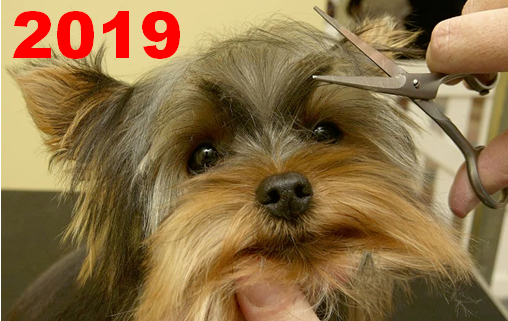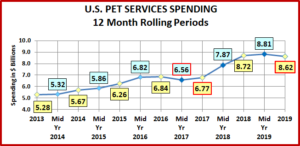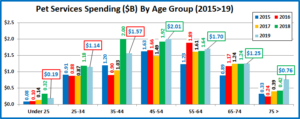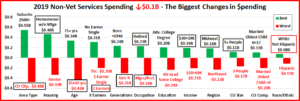2019 U.S. PET SERVICES SPENDING $8.62B…Down ↓$0.10B
Except for a small decline in 2017, Non-Vet Pet Services has shown consistent growth in recent years. In 2018, that changed as spending grew a spectacular $1.95B to $8.72B. The number of outlets offering Pet Services has grown rapidly and consumers have opted for the convenience. However, prices were also strongly increasing. In the 2nd half of 2019 spending turned down. The final 2019 $ were $8.62B, down $0.1B (-1.1%). In this report we will drill down into the data to see what groups caused this slight decline . (Note: All numbers in this report come from or are calculated by using data from the US BLS Consumer Expenditure Surveys)
Services’ Spending per CU in 2019 was $65.22, down from $66.36 in 2018. (Note: A 2019 Pet CU (67%) Spent $97.34)
More specifically, the 1.1% decrease in Total Pet Services spending came as a result of:
- 0.6% more households
- Spending 2.39% less $
- 0.69% more often
The chart below gives a visual overview of recent spending on Pet Services
You can see that after the big lift in 2018, spending essentially flattened out in 2019, similar to the pattern for the 18 months from mid-2016 through 2017. The increased availability and convenience of Services has radically driven up the spending on Services. This happened despite a return to a more normal inflation rate, +2.4%, as more people opted to use Pet Services and to do it more often. However, inflation grew even stronger, +2.5%. By the 2nd half of 2019, it made an impact as spending declined for the 1st time in 18 months. Now, let’s look at some specific spending demographics.
First, by Income Group.
In 2018, all income groups increased spending. In 2019 the middle income group, $70>150K, spent more but the lower, <$70K, and upper, $150K+ spent less. Most of the decrease (74%) came from the <$70K group and spending by the <$30K group actually fell below the level in 2015.
- <30K (28.7% of CU’s) – $19.68 per CU (-3.7%) – $0.70B, Down $0.07B (-8.9%) – This segment is getting smaller and money is tight, so Services spending is less of an option. In 2019 their Services $ fell to 9% below 2015.
- $30>70K (31.0% of CU’s) – $34.90 per CU (-13.5%) – $1.45B, Down $0.19B (-11.4%) – This group had the biggest decrease in Total Pet spending and Services $. Like the Supplies segment, their spending pattern mirrors $150K+.
- $70>100K (14.5% of CU’s) – $65.00 per CU (+13.5%) – $1.24B, Up $0.15B (+13.8%) – Their spending has slowly but consistently grown since 2016. They had the biggest $ increase in Services and Total Pet. Note: They were the only group with an increase in spending per CU.
- $100>150K (13.8% of CU’s) – $108.40 per CU (-0.2%) – $1.98B, Up $0.10B (+5.5%) – They have shown the strongest, most consistent growth since 2016. Total Pet spending was down but Services and Pet Food spending were up.
- $150K> (13.3% of CU’s) – $185.43 per CU (-7.5%) – $3.25B, Down $0.09B (-2.8%) – They have a couple of minor spending dips, including 2019. However, this is who spends the big bucks on Services – up over $1B since 2015.
Now, let’s look at spending by Age Group.
All age groups spent more on Services in 2018. In 2019 there was a clear dividing line. The groups under 45 spent less on Services (Big loser: 35>44, -$0.43B) while those 45 or older spent more. (Big winner: 75+, +$34B) Here are the specifics:
- 75> (11.2% of CU’s) – $51.36 per CU (+67.4%) – $0.76B – Up $0.34B (+80.5%) This rapidly growing group has the greatest need for pet services, but money is always an issue. In 2019 their income grew 8.1% and they spent a lot of this extra money on more Pet Services. 7.9% more CU’s spent 57.9% more $, 6.0% more often.
- 65>74 (14.9% of CU’s) – $63.45 per CU (-1.4%) – $1.25B – Up $0.01B (+0.7%). This group is also very value conscious. They are also growing in numbers. In 2019 it looks like they value shopped and found some deals, so they eked out a small gain. 2.1% more CU’s spent 4.3% less $, 3.0% more often.
- 55>64 (18.6% of CU’s) $69.38 per CU (+3.6%) – $1.70B – Up $0.07B (+4.0%) After a big drop in 2017, they began to slowly increase Services spending. In 2019, frequency fell, but they moved up to the #2 spot in Services spending, due in large part to the big decrease by the 35>44 yr olds. 0.3% more CU’s spent 9.5% more $, 5.4% less often.
- 45>54 (16.8% of CU’s)- $90.23 per CU (+8.4%) – $2.01B – Up $0.09B (+4.8%) This highest income group was the leader in Services $ until 2016. They spent a lot more in 2018 and the growth continued in 2019 due to a big increase in frequency. The result: They are back to #1 in Services $. 3.3% fewer CU’s spent 4.3% less $, 13.3% more often.
- 35>44 (16.9% of CU’s) – $70.09 per CU (-22.8%) – $1.57B – Down $0.43B (-21.7%) Spending exploded in 2018 with a $1B increase. In 2019 they spent $1.6B more on Veterinary and Food. They got some of those $ by cutting back on the more discretionary segments, Services and Supplies. 1.5% more CU’s spent 19.4% less $, 4.3% less often.
- 25>34 (16.1% of CU’s) – $53.87 per CU (-3.0%) – $1.14B – Down $0.04B (-3.3%) This group of Millennials “found” the Services segment in 2018 with a 36% spending increase. In 2019, like their 35>44 yr old brethren, they also dialed back their discretionary spending on Services and Supplies. 0.3% less CU’s spent 3.5% more $, 6.3% less often.
- <25 (5.5% of CU’s) – $26.04 per CU (-38.3%) – $0.19B – Down $0.13B – (-40.4%) After the big lift in 2018 this small, youngest group returned to being a very minor player. 3.4% fewer CU’s spent 40.6% less $, 3.9% more often.
Finally, here are some other key demographic “movers” that helped to plateau Pet Services Spending in 2019. The segments that are outlined in black “flipped” from 1st to last or vice versa from 2018. The red outline stayed the same.
In 2018 the Services spending increase was very widespread with (88%) of all segments spending more. 6 of 12 demographic categories had no segments that spent less on Services in 2018. 2019 was very different and reflected the slight decrease in spending for the segment. All categories had segments that spent less on Services and 49 total segments (51%) had decreased Services $ from 2018.
There was other evidence of the spending balance which resulted in the plateauing of Services spending. 5 segments flipped from 1st to last and 5 segments flipped from last to first. Only 1 group maintained their position – White, not Hispanics had the biggest increase in the racial/ethnic category.
There were only 2 other “usual” winners – Suburbs 2500> and those with Advanced College Degrees. In terms of “usual” losers, Renters and Hispanics are often at the bottom of Pet Spending ladders.
In our earlier analysis, we saw a very distinct pattern in the spending by age group. Americans 45 and over, led by the 75+ group, spent more on Services. Those under 45, driven down by the 35>44 year olds, spent less. Let’s see how those two patterns are reflected in the chart above.
First, the lift by the older group is evident from these winners:
- Homeowners w/o Mtge
- 75+ yrs old
- No earner, Single
- Born before 1946
- Retirees
- $30>39K (avg income of Retirees)
That’s half of the twelve winners. Now, the decrease by the younger group in these losers:
- 35>44 yrs old
- Gen X
- Married, Oldest Child <6
- 2 Earners (usually younger CUs)
- Renters (most likely <45 yrs)
- $50>69K (avg income of <35 yrs)
The pattern for the younger groups is also reinforced by the details.
There is 1 winner that seems to be out of place, the 5+ CU. Shouldn’t that be a younger CU, with kids? It turns out the largest CUs are Other Married Couples – Extra Adults, no kids. Their average age is 51 and they spent more on Services.
Once again, we are reminded that you must drill below the surface to find the true story.
After the huge lift in spending in 2018, Services spending plateaued in 2019. There were a lot of ups and downs, but overall the segment remained essentially stable at its new elevated level of spending. The young group will undoubtedly come back as their pet spending tends to be more volatile in each segment. It is very encouraging to see the increased spending by the fast growing older segment. This bodes well for the future.
COVID-19 presents the greatest uncertainty for 2020. The pandemic with widespread closures and “staying at home” likely had a big impact on this predominantly “nonessential” Pet Industry segment. We’ll get the first indication in the mid-year report published in May 2021.







